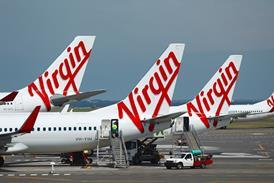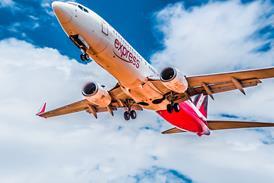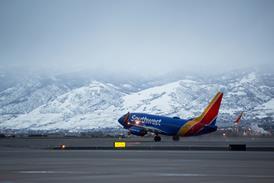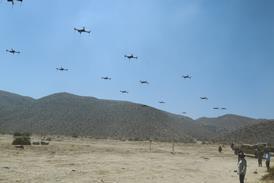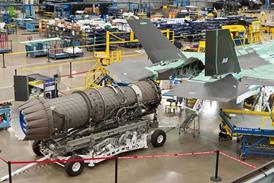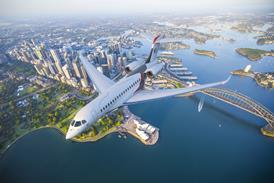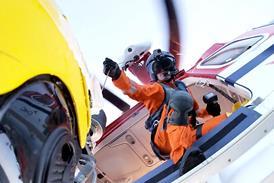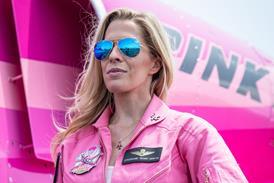Peter Henley/WICHITA
Bombardier Aerospace boasts that its flight test centre at Wichita in Kansas is undertaking more development and certification flight testing than any other company worldwide. Since Bombardier acquired Learjet in 1990, the personnel headcount of the flight test centre has grown from 20 to about 500 - an average growth rate of 50% each year for eight years.
This rate of growth has been triggered by Bombardier's consolidation of its diverse facilities and by the company's ambitious business expansion plans. Firstly, in 1991, shortly after Learjet had become part of the Bombardier conglomerate, it was decided that the Wichita site could absorb the Canadair Regional Jet development and certification programme. Then, in late 1994, the flight test centre was chosen to be the site for the development and certification of all Bombardier's rapidly expanding family of new and derivative commercial aircraft. So while the Learjet range of business jets continued to be built and flown at Wichita, they were joined for development and certification flying by the de Havilland and Canadair types which continued to be manufactured north of the border.
The Canadair Regional Jet (a 50-seat airliner) arrived in 1992, the Canadair CL-415 turbo-prop waterbomber in 1993, the de Havilland Dash 8-200 (a 35-seat regional turboprop) in 1994 and the Challenger 604 large business jet in 1995.
While the flight test centre was absorbing this range of turbofan and turboprop aircraft, the Learjet family grew simultaneously with the Model 60 mid-sized business jet appearing in 1993 and the Model 45 in 1997. Finally, the Global Express long-range, high-speed, top-of-the-market business jet underwent its development and certification flying during 1997 and 1998 at Wichita. This flood of activity has led not surprisingly to Bombardier's second boast that it has certificated more new aircraft models since 1990 than any other aerospace company. The centre is now operating 17 engineering flight test aircraft of nine different types.
There are about 25 designated test pilots and 18 flight test engineers to meet the flying task. Many of the pilots are graduates of test pilot schools and have experience of military test flying. The others have climbed "through the ranks", having been identified by the company as having the ability and ambition to progress from early beginnings as staff pilots. The sequence of nurturing usually starts from right- seat flying in aircraft under the command of a test pilot, through production aircraft test flying in command to the full role of engineering or development test pilot. Although test pilots often maintain ratings on two or three Bombardier types, they specialise in their day-to-day flying. Not only do they concentrate on one type, they also focus on specific tasks on that type - for example, handling, performance or avionics development. They also undertake flying displays and demonstration flights.
CAREER PATH
Sam Gemar, chief of operations and safety (with three missions as an astronaut behind him) thinks that more test pilots in future will be products of the in-house training and promotion scheme. He says it gave pilots a deep understanding of all aspects of flight testing, as some started as flight test engineers before graduating to piloting. It also fosters loyalty between the individual and the company and provides a clear career path, he says.
Gemar, as his job title suggests, is responsible for all aspects of ground and flight testing. The centre meets all the national and international quality assurance requirements. Gemar is now in the process of reviewing all safety issues, including risk assessment for each category of test flight. Already, high-risk flights (such as flutter tests) are identified and require two test pilots to fly them. Parachutes and helmets are worn by the crews to be used for these high risk trials. The airframes to be used are suitably modified to have an attitude recovery parachute in the tail (which can be deployed and jettisoned from the cockpit) and modified with an escape hatch opened by explosive bolts or by hydraulical means. These are usually fitted in the belly of the aircraft cabin.
The centre has three telemetry rooms which can record up to 3,500 parameters. Consequently, test flights can be monitored from the ground and the results of many test points assessed in real time. For the high-risk flights, a test pilot is available at the telemetry screens to help and advise if a problem should arise. The telemetry room personnel can relieve the crew of much of the routine tasks of flying, such as monitoring position, fuel reserves, engine behaviour and so on. Telemetry makes test flying quicker, more efficient and safer.
Wichita is within commuting distance of Roswell in New Mexico, which is used for runway tests, while Eglin AFB in Florida has a vast indoor facility capable of simulating environmental conditions from -40°C to 100°C. This facility, in conjunction with airfields such as Fairbanks Alaska, is used for cold weather trials. Wallops Island in Virginia is used for tests of ingestion of standing water on the runway. Wichita State University has a windtunnel which is available to the flight test centre, while the Canadian Government has a low-speed windtunnel.
Gemar says that the flight-test centre has established long-term relationships with the US Federal Aviation Administration, Transport Canada and the European Joint Aviation Authorities. Test pilots and flight test engineers from all three authorities are involved in development and certification programmes, while the company test pilots are involved in new aircraft design from the conceptual stage, particularly in cockpit layout and ergonomics.
During the intense development phases an aircraft type can have as many as six or seven dedicated test pilots and similar numbers of flight test engineers. Stable programmes of improvement and modification might typically have three of each.
The vast majority of the flight test centre personnel are aeronautical engineers concerned with design and certification, plus the engineering force to maintain the centre's aircraft. There are also software engineers and telemetry engineers. Overall responsibility for Bombardier Aerospace flight tests falls upon the group executive vice-president engineering and production development, John Holding. The vice-president flight test, Pete Reynolds, has immediate management responsibility, with nine managers reporting to him.
The centre works closely with the training personnel, including pilots and simulator instructors at Bombardier's customer training centre in Montreal to ensure that there is a proper cross flow of information. The flight test personnel keep the trainers up to date with the progress of new aircraft programmes and modification states. The training centre shares the feedback from customer organisations, operating and maintaining Bombardier aircraft, with the test centre.
The overall impression gained at the flight test centre is of a modern, effective department within a vibrant, innovative and progressive organisation. The centre head count is predicted to level off at more than 600 - and it looks as if there will be plenty of work for all of them.
Source: Flight International

